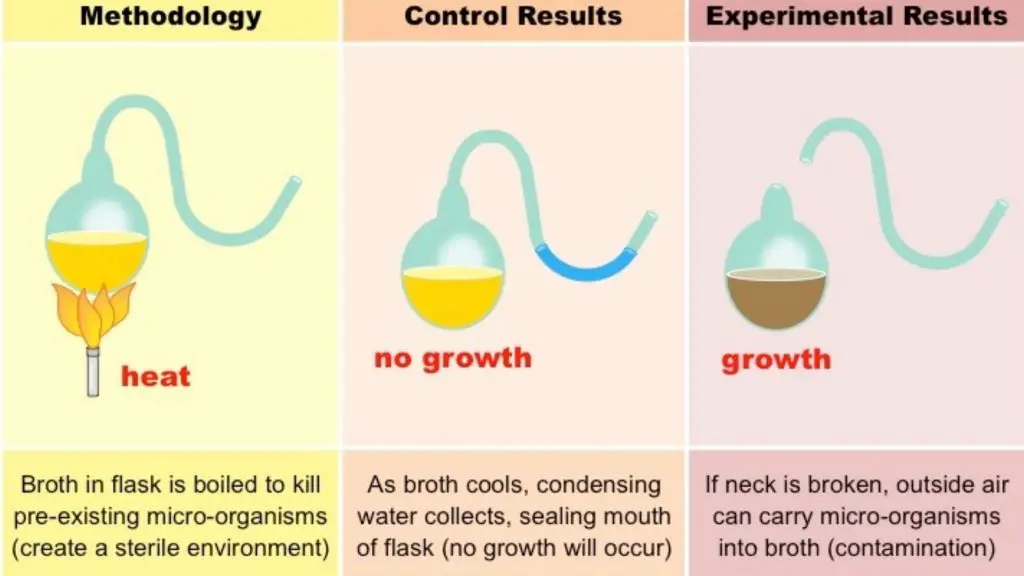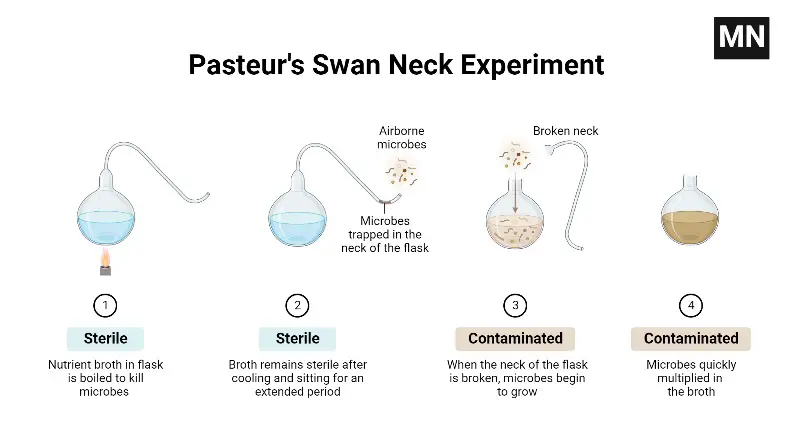Who Was Louis Pasteur?
- Louis Pasteur (1822-1895) was a pivotal figure in the field of microbiology and is frequently recognized as a foundational contributor to the modern understanding of infectious diseases. As a French chemist and microbiologist, Pasteur’s extensive research laid the groundwork for several scientific disciplines and had profound impacts on public health and medicine.
- Pasteur’s seminal work began with his challenge to the long-standing belief in spontaneous generation—the notion that life could emerge from non-living matter. Through meticulous experiments involving sterilized and sealed flasks, Pasteur demonstrated that microbial growth occurred only in open containers where exposure to air introduced microorganisms. This pivotal experiment debunked the idea that microbes could spontaneously arise and established the principle of biogenesis.
- In addition to disproving spontaneous generation, Pasteur made substantial contributions to the germ theory of disease. His research revealed that microorganisms were the causative agents of many diseases, leading to the development of strategies to prevent and control infections. This work was crucial in advancing the concept that diseases could be managed through sanitation and hygiene.
- Pasteur’s innovations extended to the practical applications of his theories. He developed the process of pasteurization, named in his honor, which involves heating liquids like milk and wine to kill harmful bacteria without altering the product’s composition. This technique has been instrumental in preventing foodborne illnesses and improving the safety of consumables.
- Moreover, Pasteur played a crucial role in the development of vaccines, creating some of the earliest immunizations for diseases such as rabies and anthrax. His work in this area not only provided protection against these deadly diseases but also laid the foundation for future vaccine development.
- Pasteur’s academic and scientific achievements earned him numerous accolades, including France’s highest decoration, the Legion of Honor. He was a key figure in the establishment of the Pasteur Institute in 1887, an institution dedicated to research in microbiology and medicine, which continues to bear his name.
- While Pasteur’s contributions are widely celebrated, his career was not without controversy. Historical evaluations suggest that Pasteur sometimes engaged in deceptive practices to advance his research and overcome competitors. Despite these issues, his contributions to science and medicine remain profoundly influential, underscoring his role as a pioneer in the fields of microbiology and immunology.

Contribution of Louis Pasteur
Louis Pasteur made several groundbreaking contributions to science, particularly in microbiology and chemistry. Here is a detailed overview of his major contributions:
- Disproving Spontaneous Generation: Pasteur challenged the prevailing belief in spontaneous generation, which posited that life could arise from non-living matter. His experiments demonstrated that microorganisms could not develop in sterilized, sealed flasks, but would proliferate if exposed to air. This work laid the foundation for modern microbiology by establishing that life comes from pre-existing life, not from spontaneous generation.
- Germ Theory of Disease: Pasteur advanced the germ theory of disease, which asserts that microorganisms are the causative agents of many diseases. His research showed that diseases are not caused by “bad air” or vapors but by specific microbes. This theory revolutionized medical practice, leading to improved sanitation, hygiene, and infection control.
- Pasteurization: Utilizing his findings on fermentation, Pasteur developed the process of pasteurization. This technique involves heating liquids to kill harmful microorganisms and prevent spoilage. It is widely used to preserve food and beverages, such as milk and wine, by preventing microbial contamination and extending shelf life.
- Sterilization Techniques: Pasteur introduced various sterilization methods, including steam sterilizers, hot air ovens, and autoclaves. These tools are essential for eliminating microorganisms from medical and laboratory equipment, thus preventing contamination and infection.
- Fermentation Studies: Pasteur’s investigations into fermentation processes revealed that specific microorganisms are responsible for different types of fermentation. This insight helped him understand and control the fermentation of alcoholic beverages and the souring of milk.
- Development of Vaccines: Pasteur’s work in vaccinology led to the creation of vaccines for several diseases, including anthrax, fowl cholera, and rabies. His development of the rabies vaccine, in particular, represented a significant advancement in preventive medicine, offering protection against a previously fatal disease.
- Molecular Asymmetry: In the field of chemistry, Pasteur studied the molecular basis of asymmetry, particularly in crystals of sodium ammonium tartrate. He discovered that these crystals existed in two mirror-image forms, a phenomenon known as chirality. This discovery laid the groundwork for stereochemistry and has profound implications for understanding molecular structures and interactions.
- Liquid Media Concept: Pasteur utilized nutrient broths to cultivate and study microorganisms. This approach allowed for the growth of bacteria in a controlled environment, significantly advancing the study of microbial life.
- Silkworm Disease Management: Pasteur identified and addressed diseases affecting silkworms, which were detrimental to the French silk industry. He developed methods to preserve healthy silkworm eggs and prevent disease spread, which continues to benefit silk production today.
- Virulence: Pasteur was among the first to recognize that the virulence of pathogens could be altered, either increased or decreased. This concept has been crucial for understanding and managing infectious diseases and their outbreaks.
The Swan Necked Flask experiment of Louis Pasteur

Louis Pasteur’s experiment with the swan-necked flask was a landmark in disproving the theory of spontaneous generation and establishing the principles of microbiology. This experiment demonstrated that microorganisms do not arise spontaneously but rather from pre-existing microorganisms. Here is a detailed examination of the experiment:
- Initial Observations: Pasteur began by filtering air through cotton. The cotton trapped particles resembling plant spores. When he placed this cotton in a sterile medium, microbial growth was observed, indicating that the particles were capable of inducing microbial contamination.
- Design of the Experiment: Pasteur used flasks with long, curved necks that resembled swan necks. These flasks contained nutrient solutions. The necks were heated in a flame and then extended into various curved shapes while remaining open to the atmosphere. This design allowed air to enter the flasks but prevented the direct entry of dust and microorganisms from the environment.
- Boiling and Cooling: The nutrient solutions within these flasks were boiled for several minutes to kill any existing microorganisms. After boiling, the solutions were allowed to cool while still being exposed to air through the curved necks.
- Observations of Sterility: Pasteur observed that no microbial growth occurred in the flasks despite their exposure to air. This outcome was attributed to the fact that dust and microorganisms present in the air were trapped in the bends of the flasks’ necks and could not reach the nutrient solutions.
- Control and Results: In contrast, when the necks of some flasks were broken, microbial growth commenced immediately. This demonstrated that once the barrier of the neck was removed, microorganisms from the air could directly contaminate the nutrient solutions.
- Conclusion: Pasteur’s experiment effectively disproved the theory of spontaneous generation by showing that life, including microorganisms, did not arise de novo but from pre-existing microorganisms. His work provided clear evidence that microbes were not spontaneously generated but rather came from external sources.
- Implications: This experiment was crucial in establishing the germ theory of disease and showed how to maintain sterility in scientific procedures. Pasteur’s findings underscored the importance of preventing microbial contamination and influenced practices in microbiology, medicine, and food safety.
By demonstrating that microorganisms could be trapped by physical barriers and did not spontaneously arise, Pasteur’s experiment with the swan-necked flask laid the foundation for modern microbiological techniques and principles.

QNA on Contribution of Louis Pasteur
What did Louis Pasteur discover?
Louis Pasteur discovered theory of biogenesis, germ theory of disease, vaccine of anthrax. He also discovered pasteurization, fermentation, etc.
What is Louis Pasteur known for?
Louis Pasteur is well known for his contribution in microbiology such as development of antrax vaccination, microbial fermentation, germ theory of disease and pasteurization.
What vaccines did Pasteur invent?
Pasteur developed vaccine for anthrax
How did Louis Pasteur die?
In 1868, Pasteur suffered a severe brain stroke that paralysed the left side of his body, but he recovered. A stroke or uremia in 1894 severely impaired his health. Failing to fully recover, he died on September 28, 1895, near Paris.
What is Pasteur’s theory?
Louis Pasteur’s pasteurization experiment illustrates the fact that the spoilage of liquid was caused by particles in the air rather than the air itself. These experiments were important pieces of evidence supporting the idea of germ theory of disease. Pasteur and a minority of other scientists believed that diseases were caused by microorganisms—germ theory. Later he proved this theory by investigating the causes of silkworm disease.
Who was Louis Pasteur’s assistant?
Charles Chamberland
Reference
- https://www.britannica.com/biography/Louis-Pasteur
- https://www.sciencehistory.org/historical-profile/louis-pasteur
- https://en.wikipedia.org/wiki/Louis_Pasteur
- https://explorable.com/discovery-of-pasteurization
- Text Highlighting: Select any text in the post content to highlight it
- Text Annotation: Select text and add comments with annotations
- Comment Management: Edit or delete your own comments
- Highlight Management: Remove your own highlights
How to use: Simply select any text in the post content above, and you'll see annotation options. Login here or create an account to get started.